The nuts and bolts of efficient and effective windrow burning
Author: Maurie Street, Grain Orana Alliance | Date: 28 Jul 2015
Take home message
- Herbicide resistance is rapidly becoming more widespread and growers need to act to save what effective herbicides that are left. Harvest weed seed control is a suite of tools to combat this and narrow windrow burning the cheapest and easiest to implement.
- Narrow windrow burning (WB) has proven to be successful in other regions on key weeds such as annual ryegrass and wild radish
- There is no reason to doubt its effectiveness here on those same key weeds. WB effectiveness on other species that shed seed early such as wild oats may be less reliable.
- Successful WB is not hard and may take some practice to become an expert. Following some simple suggestions may help avoid mistakes
- The biggest factor to success - you must cut the crop low, less than 15 cm
- There are some downsides to WB such as selection for weeds resistant to WB, negative impacts on fallow efficiency or nutrient implications but these must be weighed up against the positive for weed control and resistance management.
What is narrow windrow burning and why do it?
Narrow windrow burning (WB) is the process where the crop residue during grain harvesting is placed in a narrow windrow and then burnt.
Why?
Research has shown that a large percentage of weed seeds present at harvest that enter a header, exit in the trash fraction with the chaff and to a lesser extent, the straw fraction. If you can capture and concentrate those seeds and render them sterile by burning them, they’re not going to be there to germinate and compete with next year’s crop, hence breaking the weed’s reproductive life cycle.
It is a technique that has been widely adopted in Western Australia over the past 10 years and has shown to be a very effective tool to manage herbicide resistance for a number of key weeds such as annual ryegrass and wild radish.
But with any new tool there are some tricks of the trade to ensure the best results which will be discussed here.
Tips for successful windrow burning
For WB to be successful, growers should plan for its use a long time before you strike a match so let’s start at the beginning.
Ahead of harvest
Well ahead of harvest time consider which paddocks and crops you might like to WB. Your choice will be influenced by many characteristics but here are a few of the main considerations:
Which crop?
The trick with WB is to just burn the windrows and not the whole paddock. Despite many growers doubting this possible, it has been proven in over tens of thousands of hectares every year in Western Australia. The majority of growers in WA now use WB to some extent on their farms.
Two simple things make this possible:
1. The crop is cut short to capture the weed’s seeds into the header front. Then the entire trash from the header is deposited in a defined, narrow windrow not spread back over the paddock. This means the fuel load is in the windrow and not outside of it and the fire can only burn where there is fuel. This is demonstrated in figure 1 below showing the residue distributed over the soil surface in the conventionally harvested section on the left, which allows the fire to spread. In contrast the soil surface on the right has less residue left on the soil surface for the fire to carry on.
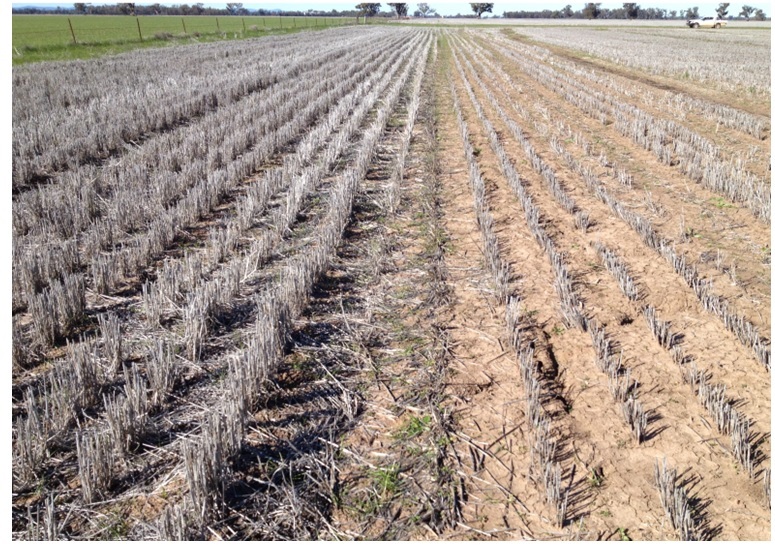
Figure 1. Remaining trash loads when a paddock is harvested for windrow burning on the right compared to the trash load being redistributed by the header when conventionally harvesting on the left. Photo taken Narromine June 2013
2. Weather conditions when windrow burning need to be calmer and cooler than what is required in more traditional paddock burns which need a little more heat and wind to ensure the fire carries.
However despite these points the fire can still get away to burn the whole paddock. Bulky cereal crops with thick stubble will be most prone to the fire getting away. So it is recommended, especially if inexperienced, to target lighter yielding cereal crops or break crops such as canola, chickpeas, lupins or field peas that tend to have lower levels of trash remaining outside the windrow.
Barley stubbles in particular have a reputation of being more difficult to burn without fire escapes and maybe better left for when more confident in WB. Experienced “windrow burners” have shown that burning wheat stubble in excess of three ton per hectare or even barley is possible as shown in the photo below.
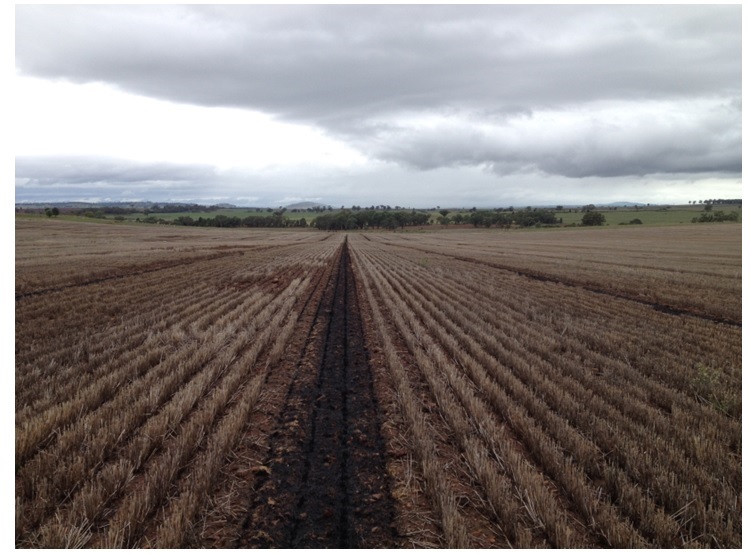
Figure 2. 4.5t/Ha Hindmarsh barley stubble windrow burnt 22nd March 2014. Photo taken 27th March 2014
Think of this: You must cut low when WB and when 2t/ha or 4t/ha crops are cut off both at 15cm they don’t often look that different. In regions with summer rainfall, large amounts of that flammable basal leaf has also long been smashed up by rain leaving behind just the stalks which limits the potential for fire escapes.
Another point to consider is heavier windrows resulting from larger crops or wider header fronts have more fuel to burn. This increase in fuel load and concentration can help insure a more complete burn in cooler or damp windrows (although not recommended). Figure 2 below shows a windrow missed in the main burn from the same paddock above that was burnt on a cool, damp and overcast 26th of April 2014. Note the white ash indicating a hot fire and no unburnt residue.
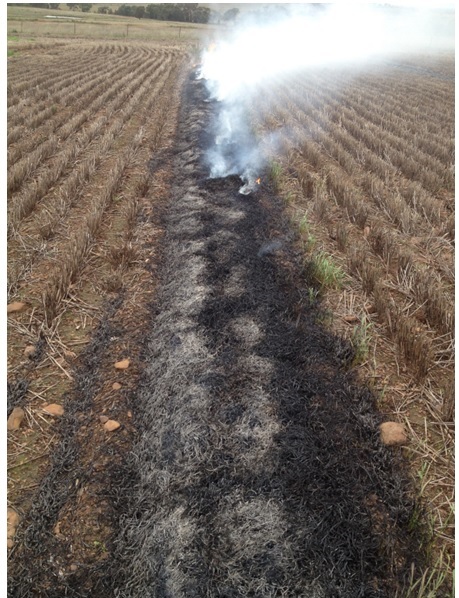
Figure 3. 4.5t/ha Hindmarsh barley stubble windrow being burnt on 26th April 2014. Weather conditions: 23 degrees C, 55% humidity. The soil surface and windrows were wet from 0.5mm rain previous day and 49mm total rainfall since 4th April 2014.
Which paddock?
You most likely won’t be looking at WB the whole farm at your first attempt so it is worth identifying which paddocks you intend to do well ahead of the rush of harvest time. Below are a few things that may help identify what paddocks are most suited to WB.
Weed types.
- WB has shown to be very effective on weeds that retain their seed at harvest above 15cm such as ryegrass and wild radish as this makes it easy to capture into the header front. So target tall weeds.
- Wild oats, brome or barley grass that shed or drop their seed may do so before the header has a chance to capture those seeds to put in the windrow so these may not be reliable candidates for WB.
- Short weeds that set seed lower than practical to capture in a header front are not capable of targeting, an example may be wireweed.
- Weeds that are able to re-sprout or re-seed after harvesting such as fleabane and sow thistle are also not likely to be good targets for WB. These two culprits also have seeds that are very mobile by air and as such could drift from the trash stream at harvest anyhow.
- Paddock conditions: To successfully capture those weeds you must cut low. Obstructions or hindrances such as rocks, sticks, gilgais or poor header driving skills that stop you getting low can reduce the effectiveness of WB. Address these issues ahead of time if possible.
Preparation of the harvester
To successfully sterilise the weed seeds during the burning process the fire must burn hot enough and long enough. This can really only be reliably achieved when the trash is concentrated into a narrow windrow. Research has shown that simply dropping the residue out of the back of the harvester in a wider windrow or a broad scale burn will not achieve the results possible from a narrow windrow burn.
To achieve this narrow windrow there will be a need for some simple modifications to the rear end of the header to simply direct the trash stream into a narrower windrow. These need not be too complicated and only need to observe a few important characteristics.
- The chute design should aim to form a windrow that is around 60cm wide however the lower opening of the chute can be slightly wider than this as the angled sides of the chute will direct the trash stream towards the middle of the machine.
- The ability to adjust the sides of the chute or the lower opening to influence the windrow width may be of some advantage in adapting to varying trash levels. In very heavy trash loads a wider windrow is suffice but crops with less trash such as chickpeas may benefit from a narrower windrow to ensure a critical mass in the windrow for burning. However many chutes are not adjustable and work fine so this may be an undue complication.
- Ensure the chute does not unnecessarily restrict the airflow from the rear of the header as this could affect grain separation
- Obstructions: Modern harvesting rates and the extra trash feeding through the header when harvesting low mean the throughput of trash is enormous. Do not underestimate what catastrophic ramifications can occur and how quickly blockages form from the smallest obstruction in flow. Design chutes that minimise the use of bolts, brackets or sharp angles near the trash flow as these tend to be problematic and should be avoided. Also aim to keep the bottom of the chute open and avoid any horizontal or near horizontal ledges where trash will need to slide as this slows the materials exit and can build up very quickly.
- Ideally build a unit that is easy to remove, particularly if you don’t intend to windrow all paddocks.
A few photos are shown below.
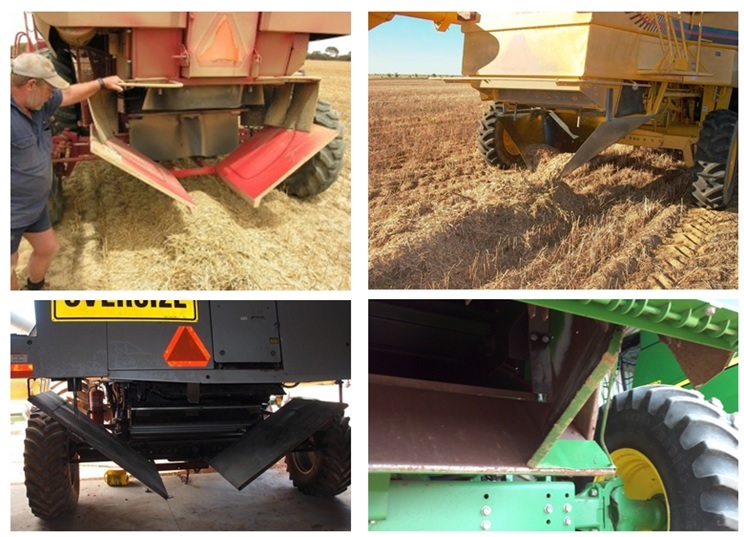
A number of videos are available concentrating on the design of chutes along with other tips on successful windrow burning
on the Weed Smart website.
At harvest
Hopefully by this time you have a clear plan of which paddocks are to be windrowed and the header chute has been prepared.
Driver training
It is important for header driver to understand what is trying to be achieved at harvest. That is to get the weeds seeds in the header front. For many years’, drivers have been directed to get the maximum speed and efficiency out of headers and that often means taking minimal straw and harvesting high. Cutting low is a new concept and old habits can be hard to break. Harvesting low can bring in other considerations as well such as:
- Cut low and observe that you are getting the weed’s seeds in the front. Adjustments to reel speed, height as well as the condition of the knife can be important particularly if weeds have begun to lodge.
- Blockages: The fitment of the chute on the rear of the header means that trash exits in a very small space. If a header comes to a stop suddenly in the paddock this space is quickly filled and the header can block from the rear forwards within seconds. Drivers need to be educated to swing out of the crop to let the residue clean out of the header unrestricted or in the least, reverse immediately to avoid costly downtime in unblocking the machine.
- Monitor grain losses. Extra straw is taken in when cutting low and this can increase the load on grain separation and if not addressed there is potential for increased grain losses. Modern headers are certainly capable of operating with much larger crops than common in Australian conditions so capacity is not the issue but adjustments may be required to the header setup and operation to cater for the increase in load.
- Operators should refer to the header manufactures instruction to identify and minimise harvest losses and maintain efficiency but below are a few key considerations:
- The increase in throughput is in straw volume not chaff, so rotor or straw walker losses are more probable. Operators should concentrate on the rotor or drum setup to ensure grain is not carried over the back as rotor or straw walker losses. Even if the grain is separated from the stalk evidenced in the windrow, it can still be carried out in the large trash load. Rectification may involve different setups. Changing concave clearances or rotor/drum speeds or changing concaves to larger sizes to allow the grain to exit easily and quickly. Other options maybe available such as extended concaves or adjustments or modification to increase opportunity for grain to exit from the rotor.
- Don’t over thrash the crop. This could increase the load on the sieves, unduly slow the machine down and the resultant windrows are chaffier and can be more prone to smouldering.
- Slow down a bit?
Cut low - getting the message?
Despite these adjustments to machine setups there still may in some cases simply be no other option but to simply slow down to minimise losses.
This is a common concern when considering WB however the perceived reduction is often worse than it really is. Foremost for many is the concept that the increased trash load taken into the front of the header has a huge drain on engine power which slows harvesting rates.
However it should be remembered that for many, there will be no requirement to run the straw choppers and or spreaders. This will save on a significant power requirement that can be directed to the increased throughput.
Another point to consider is that in a number of cases growers may already be harvesting at a height that captures a large percentage of weed seeds already. Take for example chickpeas, field peas, shorter or lower yielding wheat or barley crops or crops that have lodged. In many cases there will be little or no need to alter harvesting height simply the fitting of a chute on the rear of the header.
After harvest
For the most part a paddock harvested for windrow burning should be managed not too dissimilar to any other paddocks. As for any fallow, weeds should be controlled to both minimise moisture usage but also maximise N mineralisation and accumulation. Below are a few extra considerations for managing windrowed paddocks during the fallow.
- Delayed and staggered weed emergence: The thick layer of the stubble in the windrows can delay or hinder the emergence of weeds. The increase in groundcover can also hold moisture closer to the surface for longer supporting continued emergences resulting in stagged germinations of weeds. This condition may require the first fallow spray to be delayed to allow for the weeds to emerge from the windrow and a spray target to develop which is often only 1-2 days. However this condition seems only apparent for the first fallow spray as assumedly the windrow settles and increases density with rain often suppressing future germinations.
- Grazing of paddocks harvested for windrow burning can also have negative impacts on the effectiveness of WB. Foraging livestock will tend to seek out grain and weed seeds in the windrow, hence spreading the stubble and affecting the integrity of the windrow, resulting in lower and uneven burning temperatures and duration leading potentially to a poorer control.
Burning the rows
Burning the windrows is the most critical phase of the technique and arguably takes the most amount skill and experience. The key to getting this part right involves burning when the conditions are warm and mild enough to ensure the fire gets enough heat to sterilise the weed seeds but not too supportive of fire to see it escape from the windrows and burn the whole paddock, or worse still, the neighbour’s paddock.
The potential risk for fire escapes is influenced by four main conditions: temperature, humidity, wind speed and the curing of the fuel load. Striking the right balance of these conditions is a large part of successfully burning windrows. Many growers who have burnt many windrows in the past will be comfortable identifying the right balance through experience but less experienced growers may benefit from a tool that helps do this for them.
The McArthur fire danger index is one such tool that can do this. Developed by the CSIRO in the 1960’s it uses algorithms based on the four key characteristics listed above to produce a single number to estimate the fire risk. Originally developed and adapted to help manage and predict grass fires it is also useful to growers wishing to burn windrows safely.
The McArthur fire index is available from a number of sources but most useful to growers may be the “Pocket Fire NSW” App for iPhones.
Growers can use this App live in the paddock to help identify when conditions are most suitable for burning the windrows. Growers should aim for an index value between 5 and 15. An index value below 5 indicates conditions are too suppressive to result in a hot enough burn to completely burn the weed seeds. A value above 15 indicates conditions are too supportive of fire and the risk of the fire escaping possibly beyond acceptable levels.
A word of warning though is that wind speed can have a significant influence over the index value for any given situation. High wind speeds can often see the fire move too fast along the windrows often quickly burning the straw off the top of the windrow and leaving the chaff fraction containing the weeds seeds unburnt. It is suggested growers should place an upper limit on the acceptable wind speed for windrow burning of around 10km/hr to avoid disappointing results.
Green weeds in the windrow or along the edges can also be problematic as they reduce introduce moisture to the fuel load and can reduce the effectiveness of the fire. Growers should aim to keep weeds controlled ahead of burning periods.
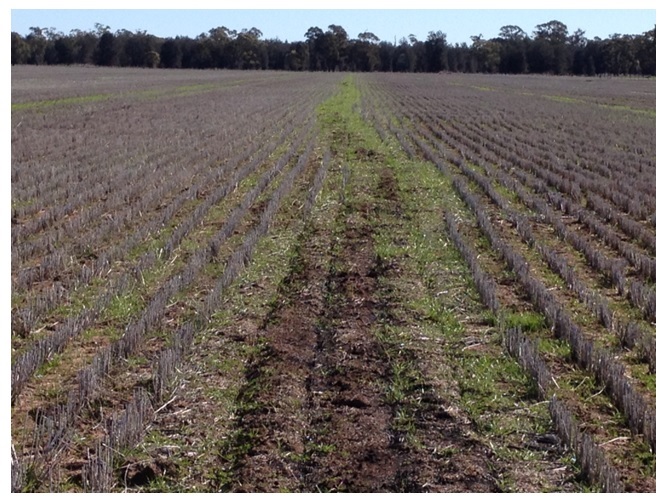
Figure 5. A burnt windrow demonstrating unacceptable control in the background possibly due to less than ideal weather conditions at burning leading to lower temperatures, duration and incomplete burning of the chaff fraction containing the majority of weed’s seeds.
The fire index will help serve as a good guide for growers to indicate when might be a good time to burn the windrows but there is nothing like actually giving it a go.
So provided growers have undertaken the other necessary precautions suggested below and conditions are indicated as OK by the fire index, actually lighting up a windrow may be the best test for ideal conditions. Growers can easily pick a typical windrow on the downside of the prevailing wind, use a garden rake to break the row say three meters apart and light one end of this section and observe how it burns. In many cases it may seem that the flames die down before the windrow is completely burnt to the ground but wait until there is no more smoke before making your final judgement as the fire may smoulder for some time whilst burning the chaff fraction on the underside of the windrow. If the burn is not achieving the desired result you may need to wait for more ideal conditions.
Before all this, growers need to prepare for burning taking the normal precautions for a stubble burn. There are the obvious considerations such as preparing firebreaks in case the fire does escape and making ready your firefighting equipment such as filling tanks and checking pumps.
If WB is a new technique in your district, warning neighbours of your intentions and filling them in on what you plan to do may avoid unnecessary panic or alarm. You may also require fire permits or permission to burn in some districts. Secure these once you have entered a period where you think you might burn and try not to stipulate one particular day as not all days are suitable. Seek permission for a longer period.
Lastly, when conditions are ideal, be prepared to act. Not every day is ideal to burn windrows and even the ones that are can change as the day gets later. Growers needs to take full advantage of suitable days when available.
A common misconception is that the entire length of the windrow needs to be lit this is wrong. You do not have to drive up and down each row to light them. Growers often light the windrows at points 200-300 meters apart by traveling perpendicular to the windrows. By lighting them at one point, the fire will burn along the windrow till that windrow ends or it meets the fire burning along the other way. How close you choose to light each row depends on you. If you have a large area to get over and you suspect weather condition will remain kind, light them further apart but if conditions are likely to decline or you want rows to burn out quickly, light them closer together.
Drip torches are an obvious choice for lighting the windrows but if large areas need to be lit an Accufire may be a better choice. An Accufire is a unit that can be mounted on the tray of a utility with an arm that mounts off the side that acts similar to a drip torch to light the windrows. The advantage of this system is that the lighting can be controlled from within the cab and the vehicle can travel up to 30km/hr to light the windrows. This allows for larger areas of windrows being lit in very little time.
Other considerations
Although WB has been shown to be effective for many growers, and despite the best advice here and from elsewhere, it doesn’t always go right and WB is not without other side effects either.
The greatest opportunity for the failure of WB is not killing the weed seeds as a result of the burn not being hot enough. This can leave large populations of weeds where the windrows were. An alternate view would be that this is quarantining the problem weeds into a distinct zone and allowing the larger areas beyond the windrow to thrive with less weed burdens. A 60cm wide band of uncontrollable (resistant) weeds has to be better than a full paddock as shown in the photo below of unburnt windrows in a paddock sown to canola with no herbicide applied to date.
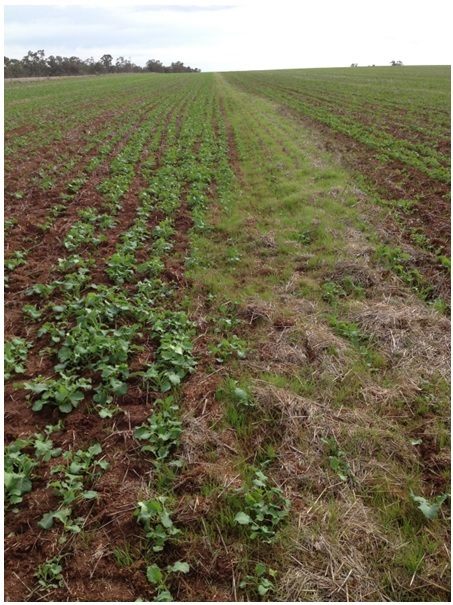
Figure 6. Concentrated, high populations of ryegrass in an unburnt windrow after paddock has been sown to canola without any pre-emergent herbicides. Burroway July 2013
In fact this very scenario has been adapted by a number of growers in Australia where the chaff fraction containing the weeds seeds is dropped in distinct areas such as tramlines and wheel tracks and growers are relying on this isolation only as a key control technique that is they are not burning them. This technique has been referred to as “windrow rotting” or “chaff lining”
In either case, not achieving a kill of the weeds seeds’, the subsequent crop should experience less competition through this quarantining and there is always the opportunity to get those seeds in a windrow next time and incinerate them then.
What about wet windrows? Well there has been plenty of experience with autumn rain ahead of burning windrows. Experience shows that 10-14 days dry weather is sufficient for the rows to dry out enough to achieve acceptable results while 3-4 days is enough to see the rows dry enough to allow the larger bulk of the windrows to be burnt to allow seeding without trouble (though with sub-optimal weed control????). Growers need to monitor predicted weather patterns and as discussed above, when conditions are ideal be prepared to act.
As with any control technique imposed on a weed population there is a risk that you will select for a characteristic that makes it resistant to that control and WB is no exception. Continued reliance on WB may select for more prostate weeds, weeds that shed seed early, quicker or even delayed maturities. As such WB or any control technique should not be relied on as the single or main control method but form part of an integrated approach to weed management.
For growers in the northern region that rely heavily on out-of-season rainfall and its conservation in the soil for crop profitable production, any action that could negatively affect this is of serious concern. The technique of WB which actively moves crop residues to the windrow and burns it rather than redistributing on the surface will have an impact on groundcover distribution. There are concerns that this could have serious ramifications to fallow efficiency and subsequent crop yields. GOA has established trials in 2013-2014 and again in 2014-2015 investigating this and preliminary results from the 2013-2014 trials have indicated a limited impact but further work is required to confirm this.
Whether or not there is an impact on fallow efficiency, the growers need to consider the control options available to them. If resistant weeds are failing to be controlled by other means, their suppressive effects on crops yields will easily exceed any reductions in fallow efficiency due to the effects of WB. Which is the lesser of the two evils?
Similarly this relocation and concentration of crop residues can affect nutrient availability and distribution. Large amounts of nutrient held in stubbles are transported and deposited in the windrow zones leaving the remaining area with lower levels of available nutrient.
WA growers have observed nutrient deficiencies, particularly potassium, outside the windrow zone and replacement fertiliser strategies come at some increase in costs compared to standard approaches.
This scenario is likely to be more acute in WA with their sandy soils with low inherent nutrition. Cropping soils of the eastern seaboard with higher clay contents generally have greater levels of nutrition particularly potassium, and as such may be buffered against these induced deficiencies. However with repeated use of WB some adjustment to fertiliser strategies may be required over time. One other strategy suggested is to alternate harvesting direction to avoid placing windrows in the same position each year to avoid compounding any effects. However this may not be possible in Control Traffic Farming systems using permanent tramlines.
In summary
Windrow burning has been proven to be effective in other Australian cropping regions on key weeds and there is no reason to doubt its effectiveness on those same weeds in other regions. But WB may not be effective in every paddock and on every weed species so planning where and when to use it is the first step to success.
To undertake WB, growers will need to make modifications to their header but these are simple and cheap to build and fit with flexible designs only needing to adhere to a few key principles. Header operators need to clear on what’s to be achieved and remember don’t stop dead.
Burning the windrows is the difficult thing and getting the weather right is the most important. Growers need to plan ahead, watch the forecast and be prepared to go when things are good.
There are some downsides to WB as with any control tool but growers need to weigh up their options and remember weed control has always had a cost. And finally WB is a terrific tool in the battle against herbicide resistance but it should be only one of many otherwise its effective lifespan may be limited.
Acknowledgements
Windrow burning is a tool championed by Grain Orana Alliance only made possible by GRDC’s support.
Contact details
Maurie Street
Grain Orana Alliance
PO Box 2880, Dubbo NSW 2830
Ph: 0400 066 201
Email: Maurie.street@grainorana.com.au
GRDC Project Code: GOA00001,
Was this page helpful?
YOUR FEEDBACK
